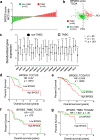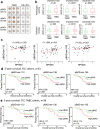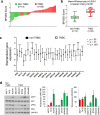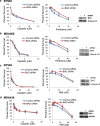Expression of the BAD pathway is a marker of triple-negative status and poor outcome
- PMID: 31767884
- PMCID: PMC6877530
- DOI: 10.1038/s41598-019-53695-0
Expression of the BAD pathway is a marker of triple-negative status and poor outcome
Abstract
Triple-negative breast cancer (TNBC) has few therapeutic targets, making nonspecific chemotherapy the main treatment. Therapies enhancing cancer cell sensitivity to cytotoxic agents could significantly improve patient outcomes. A BCL2-associated agonist of cell death (BAD) pathway gene expression signature (BPGES) was derived using principal component analysis (PCA) and evaluated for associations with the TNBC phenotype and clinical outcomes. Immunohistochemistry was used to determine the relative expression levels of phospho-BAD isoforms in tumour samples. Cell survival assays evaluated the effects of BAD pathway inhibition on chemo-sensitivity. BPGES score was associated with TNBC status and overall survival (OS) in breast cancer samples of the Moffitt Total Cancer Care dataset and The Cancer Genome Atlas (TCGA). TNBC tumours were enriched for the expression of phospho-BAD isoforms. Further, the BPGES was associated with TNBC status in breast cancer cell lines of the Cancer Cell Line Encyclopedia (CCLE). Targeted inhibition of kinases known to phosphorylate BAD protein resulted in increased sensitivity to platinum agents in TNBC cell lines compared to non-TNBC cell lines. The BAD pathway is associated with triple-negative status and OS. TNBC tumours were enriched for the expression of phosphorylated BAD protein compared to non-TNBC tumours. These findings suggest that the BAD pathway it is an important determinant of TNBC clinical outcomes.
Conflict of interest statement
The authors declare no competing interests.
Figures





Similar articles
-
Revealing Cellular Heterogeneity and Key Regulatory Factors of Triple-Negative Breast Cancer through Single-Cell RNA Sequencing.Front Biosci (Landmark Ed). 2024 Aug 19;29(8):290. doi: 10.31083/j.fbl2908290. Front Biosci (Landmark Ed). 2024. PMID: 39206896
-
Highly heterogeneous-related genes of triple-negative breast cancer: potential diagnostic and prognostic biomarkers.BMC Cancer. 2021 May 31;21(1):644. doi: 10.1186/s12885-021-08318-1. BMC Cancer. 2021. PMID: 34053447 Free PMC article.
-
Integrated machine learning algorithms identify KIF15 as a potential prognostic biomarker and correlated with stemness in triple-negative breast cancer.Sci Rep. 2024 Sep 13;14(1):21449. doi: 10.1038/s41598-024-72406-y. Sci Rep. 2024. PMID: 39271768 Free PMC article.
-
Update on the Treatment of Early-Stage Triple-Negative Breast Cancer.Curr Treat Options Oncol. 2018 Apr 14;19(5):22. doi: 10.1007/s11864-018-0539-8. Curr Treat Options Oncol. 2018. PMID: 29656345 Review.
-
Biology and Management of Patients With Triple-Negative Breast Cancer.Oncologist. 2016 Sep;21(9):1050-62. doi: 10.1634/theoncologist.2016-0067. Epub 2016 Jul 11. Oncologist. 2016. PMID: 27401886 Free PMC article. Review.
Cited by
-
Pan-cancer analysis reveals TAp63-regulated oncogenic lncRNAs that promote cancer progression through AKT activation.Nat Commun. 2020 Oct 14;11(1):5156. doi: 10.1038/s41467-020-18973-w. Nat Commun. 2020. PMID: 33056990 Free PMC article.
-
Vertical pathway inhibition of receptor tyrosine kinases and BAD with synergistic efficacy in triple negative breast cancer.NPJ Precis Oncol. 2024 Jan 10;8(1):8. doi: 10.1038/s41698-023-00489-3. NPJ Precis Oncol. 2024. PMID: 38200104 Free PMC article.
-
BAD regulates mammary gland morphogenesis by 4E-BP1-mediated control of localized translation in mouse and human models.Nat Commun. 2021 May 19;12(1):2939. doi: 10.1038/s41467-021-23269-8. Nat Commun. 2021. PMID: 34011960 Free PMC article.
-
Digital spatial profiling identifies the tumor center as a topological niche in prostate cancer characterized by an upregulation of BAD.Sci Rep. 2024 Aug 31;14(1):20281. doi: 10.1038/s41598-024-71070-6. Sci Rep. 2024. PMID: 39217197 Free PMC article.
-
The role of BCL-2 family proteins in regulating apoptosis and cancer therapy.Front Oncol. 2022 Oct 12;12:985363. doi: 10.3389/fonc.2022.985363. eCollection 2022. Front Oncol. 2022. PMID: 36313628 Free PMC article. Review.
References
-
- Lara-Medina, F. et al. Triple-negative breast cancer in hispanic patients: High prevalence, poor prognosis, and association with menopausal status, body mass index, and parity. Cancer, 10.1002/cncr.25961 (2011). - PubMed
Publication types
MeSH terms
Substances
Grants and funding
LinkOut - more resources
Full Text Sources
Molecular Biology Databases
Research Materials

